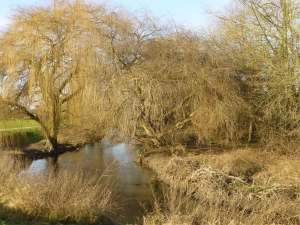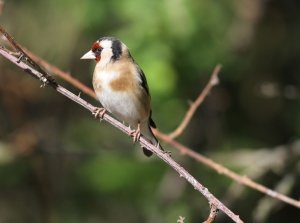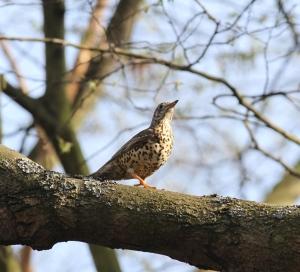RSPB Bexley Local Group Walk – Hall Place South and Crayford Rough
Tuesday 13th January 2014 – Leaders Ralph and Brenda Todd
Ninety minutes before our walk began the skies were thick grey and heavy rain had just ceased, within 90 minutes of us ending our walk this morning there was 100% dark grey cloud cover then high wind driven rain across the skies. The 18 members who joined us would hopefully have been delighted that the intervening period proved to be a lovely Spring-like day with a clear blue sky, sunshine and great tits calling as if seeking a mate.
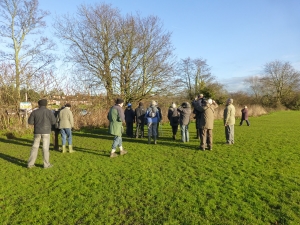
Attendees, several of whom had never been to Crayford Rough before, enjoy bird-watching in the winter sun. (Photo: Brenda Todd)
The earlier rain had made walking a little slippery and as we made our way from the car park into the open meadows and along the River Cray we constantly stopped to look at the common birds, blue, great and long-tailed tit with the latter seemingly the most numerous. Robins and chaffinches and a single coal tit also fed amongst the willows and alders. On the waterlogged football pitches a large gathering of gulls were quite difficult to sort through given the powerful sunshine but we did eventually decide most (around 120) were black-headed gulls with about a dozen common and a single herring gull amongst them (almost all on the fringes of the black-headed).
Michael Heath, Thames21 Cray River-keeper explained some of the recent work undertaken by the North West Countryside Project and Environment Agency (EA) to enhance the wildlife value of the river margin where gabions had been put in as part of the flood defences.
Goldfinches, jay and singing song thrush were encountered around here as was a lovely male sparrowhawk briefly circling overhead -well spotted by one member.
Continuing towards Crayford we passed through the gate accessing Crayford Rough, an area apparently new to the majority of the group. In addition to the relatively large number of magpies and parakeets there were moorhen and mallard on the river, the odd chaffinch and probable greenfinch in the nearby trees but all was overshadowed when a water rail broke cover and flew a short distance dropping into an area of broken reed/vegetation. Some time was spent trying to relocate it when it suddenly flew back into another dense area of vegetation, some were lucky to see it whilst a few others were watching a grey wagtail. After more perseverance it ran into cover giving most a good view before walking up a bank and into very thick ivy/vegetation on the river’s edge.
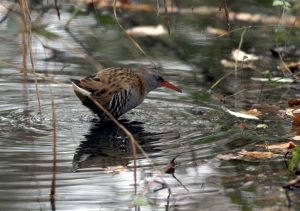
Relatively good, albeit brief, views of that elusive species the Water Rail, were a highlight of the walk. (Photo, Ralph Todd)
Upbeat after this encounter we continued on to where the EA were undertaking some mitigation work to protect common lizards and slow worms in advance of work they will be carrying out to the weir in the Spring. Chris Rose (Vice Chair of Bexley Natural Environmental Forum) outlined a nearby site for pyramidal and bee orchids.
We wandered through fairly dense vegetation (fantastic in spring/early summer for warblers and other breeding species) before arriving at the now flooded drainage ditch that we had hoped to walk down. From here, some explanation was given about the management of the site before being interrupted by a calling great-spotted woodpecker – most eventually managed a good view – one description of it “pirouetting around the trunk”. From here we were also able to look across to Braeburn Park, a site recently taken over by London Wildlife Trust, which has now commenced habitat management work there.
We retraced our steps along the River Cray towards to the Sports Pavilion car park adding dunnock, wren and mistle thrush to the morning’s list.
So with muddied boots but sun soaked warmth the walk was concluded with a modest 27 common species but hopefully enjoyed by all those present.
Species seen: Cormorant (over), Mallard, Sparrowhawk, Moorhen, Water Rail, Black-headed Gull, Common Gull, Herring Gull, Woodpigeon, Ring-necked Parakeet, Great Spotted Woodpecker, Grey Wagtail, Wren, Dunnock, Robin, Blackbird, Song Thrush, Mistle Thrush, Long-tailed Tit, Coal Tit, Blue Tit, Great Tit, Jay, Magpie, Carrion Crow, Chaffinch, Greenfinch.

